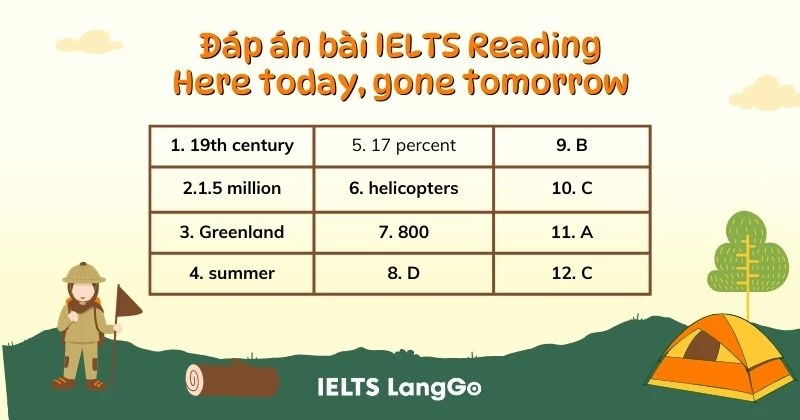



Du lịch là một chủ đề rất thú vị trong khi ôn luyện thi IELTS, nó có thể giúp cho chúng ta có thêm những kiến thức cần biết khi đi du lịch và những địa điểm thú vị trên thế giới.
Với chủ đề thú vị này hãy tham khảo bài đọc 'Here today, gone tomorrow' để trau dồi kỹ năng làm bài IELTS Reading (qua 2 dạng bài Summary Completion và Matching Features) cũng như biết thêm những điều liên quan đến du lịch.
- Hãy nhớ rằng các câu trả lời có thể không theo thứ tự của bài đọc.
- Tuy nhiên các câu trả lời co thể sẽ nằm tập trung ở một đoạn văn nào đó chứ không nằm rải rác trong cả bài đọc.
- Hãy chú ý vào ngữ pháp vì nó có thể sẽ giúp chúng ta tìm ra manh mối cho câu trả lời.
- Nếu phải chọn từ vựng trong bài đọc thì phải đọc kỹ đề yêu cầu 'no more than -- words' để chọn đúng số từ
- Kiểm tra lại xem nó đã đúng ngữ pháp và ý nghĩa chưa khi bạn hoàn thành.
- Scan đoạn văn chứa các tùy chọn A,B,C, etc- và gạch chân chúng. Chúng luôn theo thứ tự trong đoạn văn khi chúng ở trong box, nhưng chúng có thể lặp lại nhiều lần.
- Gạch chân những Key Words có trong câu hỏi.
- Đọc một cách cẩn thận từng tùy chọn và nó phải phù hợp với câu hỏi.
Trên đây là một số lưu ý khi làm 2 dạng bài rất hay gặp trong IELTS Reading, các bạn hãy áp dụng ngay để làm bài đọc 'Here today, gone tomorrow' sau đây nhé!
| Here today, gone tomorrow The Arctic and Antarctica are now within reach of the modern tourist, with many going to see these icy wildernesses before it's too late. Christian Amodeo reports on the growth of polar tourism. Travel at the North and South Poles has become an expensive leisure activity, suitable for tourists of all ages. The poles may be inhospitable places, but they are seeing increasing numbers of visitors. Annual figures for the Arctic, where tourism has existed since the 19th century, have increased from about a million in the early 1990s to more than 1.5 million today. This is partly because of the lengthening summer season brought about by climate change. Most visitors arrive by ship. In 2007, 370,000 cruise passengers visited Norway, twice the number that arrived in 2000. Iceland, a country where tourism is the second-largest industry, has enjoyed an annual growth rate of nine percent since 1990. Meanwhile, Alaska received some 1,029,800 passengers, a rise of 7.3 percent from 2006. Greenland has seen the most rapid growth in marine tourism, with a sharp increase in cruise-ship arrivals of 250 percent since 2004. The global economic downturn may have affected the annual 20.6 percent rate of increase in visitors to the Antarctic - last season saw a drop of 17 percent to 38,200 - but there has been a 760 percent rise in land-based tourism there since 1997. More people than ever are landing at fragile sites, with light aircraft, helicopters and all-terrain vehicles increasingly used for greater access, while in the past two seasons, ‘fly-sail’ operations have begun. These deliver tourists by air to ships, so far more groups can enjoy a cruise in a season; large cruise ships capable of carrying up to 800 passengers are not uncommon. In addition, it seems that a high number of visitors return to the poles. ‘Looking at six years’ worth of data, of the people who have been to the polar regions, roughly 25 percent go for a second time,’ says Louisa Richardson, a senior marketing executive at tour operator Exodus. In the same period that tourism has exploded, the ‘health’ of the poles has ‘deteriorated’. ‘The biggest changes taking place in the Antarctic are related to climate change,’ says Rod Downie, Environmental Manager with the British Antarctic Survey (BAS). Large numbers of visitors increase these problems. Although polar tourism is widely accepted, there have been few regulations up until recently. At the meeting of the Antarctic Treaty in Baltimore, the 28 member nations adopted proposals for limits to tourist numbers. These included safety codes for tourist vessels in Antarctic waters, and improved environmental protection for the continent. They agreed to prevent ships with more than 500 passengers from landing in Antarctica, as well as limit the number of passengers going ashore to a maximum of 100 at any one time, with a minimum of one guide for every 20 tourists. ‘Tourism in Antarctica is not without its risks,’ says Downie. After all, Antarctica doesn’t have a coastguard rescue service.’ ‘So far, no surveys confirm that people are going quickly to see polar regions before they change,’ says Frigg Jorgensen, General Secretary of the Association of Arctic Expedition Cruise Operators (AECO). ‘However, Hillary Clinton and many other big names have been to Svalbard in the northernmost part of Norway to see the effects of climate change. The associated media coverage could influence others to do the same.’ These days, rarely a week passes without a negative headline in the newspapers. The suffering polar bear has become a symbol of a warming world, its plight a warning that the clock is ticking. It would seem that this ticking clock is a small but growing factor for some tourists. ‘There’s an element of “do it now”,’ acknowledges Prisca Campbell, Marketing director of Quark Expeditions, which takes 7,000 People to the poles annually. Leaving the trip until later, it seems, may mean leaving it too late. |
Questions 1-7
Complete the summary below.
Choose NO MORE THAN TWO WORDS AND/OR A NUMBER from the passage for each answer.
| Polar tourism - the figures Tourism in the Arctic began in the 1. ……………. and visitor numbers have risen since that time. These days, over 2. ……………. people travel there, mostly by ship. The country with the greatest increase in visitors is 3. ……………. . Tourism has expanded in the Arctic because the 4. ……………. lasts longer than it used to. Travel to the Antarctic has fallen by 5. ……………. over the past year. However, many more people are using small planes and 6. ……………. to land on the ice. Aircraft are also taking visitors to huge ships that hold as many as 7. ……………. tourists. |
Questions 8-12
Look at the following statements and the list of people below.
Match each statement with the correct person, A-D.
NB You may use any letter more than once.
8. ……………. Some tourists believe they should not delay their trip to the poles.
9. ……………. There are some dangers to travelling in Antarctica.
10. ……………. Some famous people have travelled to polar regions to look at the impacts of global warming.
11. ……………. Some tourists make more than one trip to the poles.
12. ……………. There is no evidence that visitors are hurrying to the poles.
List of People
A Louisa Richardson
B Rod Downie
C Frigg Jorgensen
D Prisca Campbell
ĐÁP ÁN CHI TIẾT

1. 19th century
Dẫn chứng: "Annual figures for the Arctic, where tourism has existed since the 19th century..." (Số liệu hàng năm ở Bắc Cực, nơi du lịch đã tồn tại từ thế kỷ 19...)
Giải thích: Câu này xác nhận rằng du lịch ở Bắc Cực đã có từ thế kỷ 19. Đây là thời điểm mà hoạt động du lịch bắt đầu ở khu vực này, phù hợp với câu hỏi về thời gian du lịch tại Bắc Cực bắt đầu.
2.1.5 million
Dẫn chứng: "Annual figures... have increased from about a million in the early 1990s to more than 1.5 million today." (Số liệu hàng năm... đã tăng từ khoảng một triệu vào đầu những năm 1990 lên hơn 1,5 triệu người ngày nay.)
Giải thích: Câu này cho thấy số lượng du khách hiện tại đến Bắc Cực đã vượt quá 1,5 triệu. Đây chính là số liệu phù hợp với câu hỏi về số lượng du khách.
3. Greenland
Dẫn chứng: "Greenland has seen the most rapid growth in marine tourism, with a sharp increase in cruise-ship arrivals of 250 percent since 2004. (Greenland đã chứng kiến sự tăng trưởng nhanh nhất trong du lịch đường biển, với sự gia tăng đột biến 250% số chuyến tàu du lịch kể từ năm 2004.)
Giải thích: Câu này cho thấy Greenland có tốc độ tăng trưởng du lịch nhanh nhất trong khu vực Bắc Cực, nên đây là câu trả lời đúng cho câu hỏi về quốc gia có sự gia tăng số lượng du khách lớn nhất.
4. summer
Dẫn chứng: "This is partly because of the lengthening summer season brought about by climate change." (Điều này một phần là do mùa hè kéo dài hơn do biến đổi khí hậu.)
Giải thích: Câu hỏi yêu cầu tìm lý do khiến du lịch Bắc Cực phát triển, và câu này chỉ ra rằng mùa hè dài hơn khiến du lịch trở nên dễ tiếp cận hơn, làm gia tăng số lượng khách.
5. 17 percent
Dẫn chứng: "... last season saw a drop of 17 percent to 38,200..." (Mùa trước đã chứng kiến sự sụt giảm 17%, xuống còn 38.200 khách.)
Giải thích: Câu hỏi yêu cầu tìm mức độ giảm sút của du lịch Nam Cực trong năm qua, và câu này cung cấp chính xác số liệu về sự sụt giảm.
6. helicopters
Dẫn chứng: "More people than ever are landing at fragile sites, with light aircraft, helicopters and all-terrain vehicles increasingly used for greater access..." (Nhiều người hơn bao giờ hết đang hạ cánh tại các khu vực dễ bị tổn thương, với máy bay hạng nhẹ, trực thăng và xe địa hình ngày càng được sử dụng nhiều hơn để tiếp cận tốt hơn...)
Giải thích: Câu văn liệt kê ba loại phương tiện: light aircraft, helicopters, all-terrain vehicles. "Small planes" trong câu hỏi có thể hiểu là "light aircraft", vì vậy từ còn lại hợp lý nhất là "helicopters".
7. 800
Dẫn chứng: "... large cruise ships capable of carrying up to 800 passengers are not uncommon."
(... những con tàu du lịch lớn có thể chở tới 800 hành khách không phải là hiếm.)
Giải thích: Câu này trực tiếp nhắc đến số lượng hành khách tối đa mà tàu du lịch có thể chở, phù hợp với câu hỏi.
8. D
Dẫn chứng: "There’s an element of ‘do it now’, acknowledges Prisca Campbell..." (Có một yếu tố ‘hãy làm ngay bây giờ’, Prisca Campbell thừa nhận...)
Giải thích: Câu hỏi đề cập đến việc một số du khách cảm thấy cần phải đi du lịch đến cực trước khi quá muộn. Câu trích dẫn của Prisca Campbell nói rằng một số khách du lịch cảm thấy cần đi ngay, nên câu trả lời đúng là D.
9. B
Dẫn chứng: "‘Tourism in Antarctica is not without its risks,’ says Downie. After all, Antarctica doesn’t have a coastguard rescue service.’" (‘Du lịch ở Nam Cực không phải là không có rủi ro’, Downie nói. Rốt cuộc, Nam Cực không có dịch vụ cứu hộ bờ biển.)
Giải thích: Câu hỏi đề cập đến các nguy hiểm khi du lịch ở Nam Cực. Rod Downie nhấn mạnh những rủi ro và việc không có dịch vụ cứu hộ, nên đây là câu trả lời chính xác.
10. C
Dẫn chứng: "However, Hillary Clinton and many other big names have been to Svalbard..." (Tuy nhiên, Hillary Clinton và nhiều nhân vật nổi tiếng khác đã đến Svalbard...)
Giải thích: Câu hỏi đề cập đến việc một số nhân vật nổi tiếng đã đến thăm vùng cực để quan sát tác động của biến đổi khí hậu. Câu trích dẫn từ Jorgensen nói rõ rằng Hillary Clinton và những người nổi tiếng khác đã đến đây, nên câu trả lời đúng là C.
11. A
Dẫn chứng: "Of the people who have been to the polar regions, roughly 25 percent go for a second time,’ says Louisa Richardson." (Trong số những người đã đến vùng cực, khoảng 25% quay lại lần thứ hai, Louisa Richardson nói.)
Giải thích: Câu hỏi đề cập đến việc một số du khách đến vùng cực nhiều hơn một lần. Câu trích dẫn của Richardson nêu rõ con số 25% khách quay lại, nên câu trả lời đúng là A.
12. C
Dẫn chứng: "‘So far, no surveys confirm that people are going quickly to see polar regions before they change,’ says Frigg Jorgensen." (‘Cho đến nay, chưa có khảo sát nào xác nhận rằng mọi người đang nhanh chóng đến thăm vùng cực trước khi chúng thay đổi’, Frigg Jorgensen nói.)
Giải thích: Câu hỏi nói về việc không có bằng chứng cho thấy khách du lịch đang vội vã đến vùng cực. Câu trích dẫn của Jorgensen xác nhận điều này, nên câu trả lời đúng là C.
Như vậy, bài viết trên đã giúp bạn luyện thi IELTS Reading chủ đề Tourist Attractions với bài đọc Here today, gone tomorrow kèm đáp án và giải thích chi tiết, đồng thời cung cấp cách làm các dạng bài Reading của bài đọc này giúp bạn tiến bộ nhanh chóng. Đừng quên theo dõi IELTS LangGo để học thêm nhiều kiến thức hay về IELTS bạn nhé!



ĐẶT LỊCH TƯ VẤN MIỄN PHÍ LỘ TRÌNH Săn ƯU ĐÃI lên tới 12.000.000đ